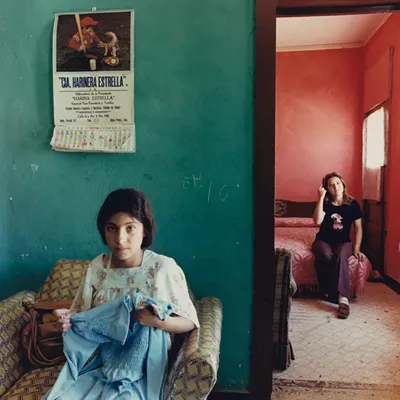And she's got a plan for the foam packing peanuts that litter the house after holidays. Not to mention shards of tinfoil that are too small to wrap food in and too big to throw out.
Allen makes them all into art.
In her hands, the leathery pieces of red-brown palm metamorphose into bird cages--sort of--or giant teardrops hanging from a lamp. The packing peanuts turn into the curls of a sculpted woman's hair. Tinfoil finds its way into yarn weavings.
The young artist shows off her way with recyclables in a lively one-person show of mixed-media works, Touching the Surface, at the UA's Kachina Gallery on the third floor of the Student Union. Allen does have a few more conventional pieces, including a couple of nice charcoal drawings of female nudes and some photo collages that combine photographic images with shiny patterned wrapping paper. But mostly, she explains in an artist's statement, she dislikes limiting herself to traditional art materials. She revels in the second-hand, in discards, in feathers and towels and tape.
The palm sculptures are probably the most original creations in the show. In "Aviary," a collection of six wall pieces, Allen nudges the leathery palm bark into the shape of a woman's bodice. Then she weaves assorted materials to fill the cleavage--the space that gets ripped open in bodice-ripper novels and movies. She uses conventional yarn for at least one of these weavings, but elsewhere, she favors shiny red ribbon, strips of Chinese newspapers, tinfoil, tan packing tape.
And here's where the aviary of the title comes in: Threaded into every one of these weavings is at least one small bird in white yarn. The whimsical birds, perhaps, are meant to bring the work full cycle back to its origins in Tucson's palm trees, home to zillions of birds.
Those pink packing peanuts are another matter altogether. With their rolling curves, they must have struck Allen as akin to hair curls. (They also look like the cylindrical pink hair curlers that used to pinch the scalps of young girls, but Allen is likely too young to have seen those.) She's made no fewer than 11 female heads out of foam and painted them black. The faces are realistic and lovely, all of them with downcast eyes, melancholy lips and white tears tumbling down their cheeks.
The pink peanuts are glued onto their heads in different historical hairdos. One head has a short flapper bob, another a Marie Antoinette crown of curls, still another a punk rocker's Mohawk. Allen has given the ensemble of heads the punning title of "Packaging," slyly alluding not only to her materials but to the various way women package their bodies for public consumption. The tears testify that their skin-deep beauty doesn't necessarily bring happiness.
Tinfoil has walk-on parts in several works, including the weaving "Evolving Beyond the Machine." Here, the tinfoil takes on a machine-like look. Its shiny silver is arranged into hard angles, and it's deliberately juxtaposed against soft yarns that evoke the organic messiness of the landscape. The rendition isn't literal, but a lozenge of yellow yarns is like a sun floating against a woven red-orange sky and above a blue-gray stretch of land.
In "Escape," tinfoil stars. A 3-D wall sculpture four feet across, the piece is made of dozens of strips of tinfoil bristling outward into the air. Allen has arranged the nicely rounded silver pieces in four concentric ovals, surrounding a black woven yarn center. Between the imagery and the title, it's hard to escape a sexual meaning. "Escape" just may be a big--and ouchy--vagina.
"Desire" pushes the sex theme further. Vaguely beehive-shaped, this pedestal sculpture is made of mint-green terrycloth toweling draped over a steel frame. Red-glass teardrops are arranged around an oval opening toward the base. Lovely soft white feathers ring the opening; inside is a white feather nest. Sexual "Desire" is a little more comfortable than sexual "Escape"; there's a lesson there somewhere.
"Emergency?" puts a humorous spin on genital disasters. A clear plastic tube filled with tiny tampons stands vertically--read vaginally--in the middle of a cloth loosely woven of cotton strips. The cloth is white, stained red, evidence of a menstrual mishap. Favoring hygiene over her recycling principles in this case, Allen has wisely opted to employ unused tampons in the piece.
Brand-new tampons notwithstanding, you get the impression that this inventive young artist is willing to take on any and all materials in service to her art. Eventually, perhaps, she'll narrow down a bit to her strengths, abandoning the conventional photo collages, for instance, to concentrate on her more distinctive mixed-media weavings.
But the work is already fun and energetic--and ambitious. Allen not only touches lightly on large themes about consumption and about the body; she does her bit to clean up Tucson's trash.










